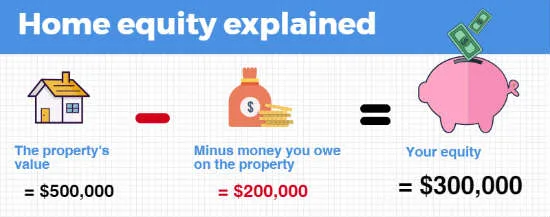When you choose to refinance your existing home loan, you should take into account the amount of equity you’ve built up in your home. If your equity is less than 20% of the property's value then your new lender will charge you lenders mortgage insurance (LMI).
First up: What is equity?
When you make payments towards the principal amount of your home loan you build up equity in your home. The equity is the difference between your home's value and what you have left to repay on your loan.
This is the money you can expect to remain if you sell your home and repay your loan with the proceeds from the sale.
For example, if you live in a home worth $750,000 and you still have to repay $250,000, you have $500,000 in equity. The equation for equity is given below:

How much equity do I need when refinancing?
Many loans come with a maximum LVR of 95%, which means you cannot borrow more than 95% of the value of your home. What this also means is that if you wish to refinance you must have at least 5% equity in your home.
To put yourself in the best position to refinance, you should have at least 20% equity in your home.
Applying for a refinanced home loan with no equity is difficult unless you can get someone to go guarantor. Find out more about how you can refinance your home loan with little or no equity.
Remember that lenders look at your equity as a means to assess risk. The more equity you have, the lower risk you present to the lender.
Finder survey: When did Australians last compare their home loan interest rate?
| Response | |
|---|---|
| In the last 6 months | 29.14% |
| In the last year | 17.45% |
| In the last month | 17.27% |
| I don't have a home loan | 14.39% |
| More than a year ago | 13.85% |
| I've never compared my interest rate | 7.91% |
What if I don't have at least 20% in equity?
When you choose to refinance without at least 20% equity in your home, there's a good chance you'll have to pay lenders mortgage insurance again. This is because you cannot transfer the existing LMI to the new loan, despite the fact that your previous lender is no longer at risk.
While getting a rebate when you terminate your LMI policy is possible, it’s crucial that you ask for it. Most LMI policies don't offer rebates if you've held your home loan for longer than 12 or 24 months. Even if you do get a rebate, this is usually not for the full amount. If you have to get LMI again, you could pay thousands.
Consider LMI costs in the following examples which use Finder's LMI calculator.
| Home value | Equity | LVR | LMI cost |
|---|---|---|---|
| 350,000 | 60,000 | 82.86% | $1,728 |
| 500,000 | 50,000 | 90% | $8,428 |
| 600,000 | 80,000 | 86.67% | $7,316 |
As you can see, the cost of LMI can be highly expensive which can outweigh the value of any savings you could net from switching lenders.
Calculate how a rate rise might affect your loan repayments
Alternative options
Before comparing refinancing options, find out how much equity you have in your home. If you don’t have a 20% deposit saved but aren’t far off the mark, it might make sense to wait until you've built up a higher amount of equity. Check out this helpful guide to paying off your mortgage faster (and thus building equity).
Alternatively, you can consider applying for a guarantor home loan or applying with specialist banks that may have less stringent lending criteria for refinance mortgages.
Looking to refinance? Compare your options now
Why you can trust Finder's home loan experts




More guides on Finder
-
4 disadvantages of refinancing your home loan
Refinancing your home loan can get you a better interest rate, adjust your loan term and take advantage of new features, but there are some things to look out for to make sure it's the right decision for you.
-
Fast refinance
Learn how to refinance your home loan fast and save money in the process.
-
Refinancing an SMSF home loan
Refinancing an SMSF home loan is the same as refinancing any other home loan, although it requires some extra thought and consideration.
-
Refinancing an interest only home loan
Refinancing to an interest-only loan can give you lower mortgage repayments and tax benefits for some investors.
-
How to refinance a home loan
Our comprehensive guide to refinancing your home loan shows you how to refinance a home loan and start saving today.
-
Should I refinance my home loan now?
Interest rates are low, giving you the chance to save thousands. See how much less you could pay for your home loan by refinancing today.
-
Refinance your home loan to buy an investment property
Learn how to refinance a home loan to fund the purchase of an investment property.
-
Debt consolidation by refinancing your home loan
Consolidate debt, pay less interest and reduce your monthly repayments by refinancing into a single home loan. Here's how it works.
-
Refinance without equity
Refinancing with no equity is not easy. Sometimes you may not have much equity, but it may still be possible to refinance your home loan.
-
Switching home loans? Hidden costs of refinancing
Keen to switch home loan to a better deal? Refinancing could save you thousands, but make sure you know all the fees and charges before you switch.
Ask a question
